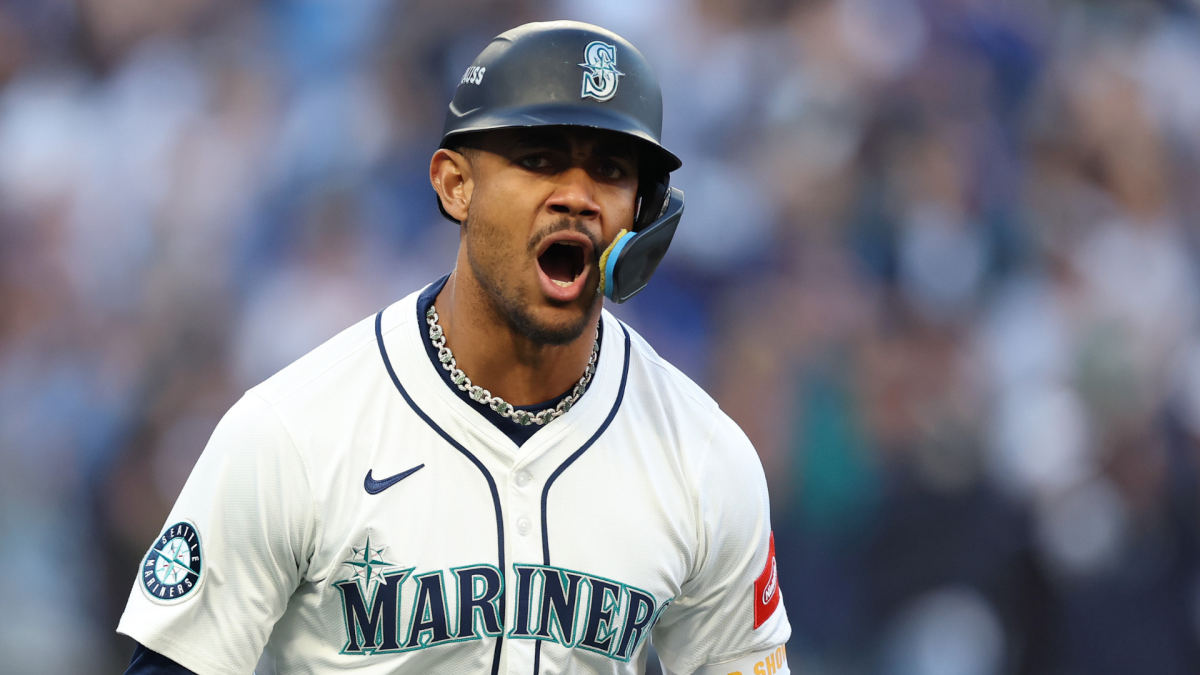Prior to the start of this series, I previewed what I see as the key question in an unstoppable-force-vs-immovable-object matchup: Toronto hitters’ propensity to swing at strikes vs. the Mariners pitching philosophy of dominating the zone. Early in Game 1, it seemed like that question would be answered decisively when George Springer homered off Bryce Miller’s very first pitch, a fastball that had good velocity and location on the outer edge of the zone but maybe needed to be just a little higher or lower to facilitate weaker contact.
But after that initial snafu, Miller settled in, and so did the rest of the Mariners pitching staff, stretching over into Game 2. For every pitcher outside of Emerson Hancock in low-leverage duty (and struggling with throwing strikes), the Blue Jays swung at almost or over 50% of every Mariner pitcher’s offerings: 40 of Miller’s 76 pitches, 34 of Logan Gilbert’s 58, 15 of Eduard Bazardo’s 30, and even a shaky Carlos Vargas coaxed 17 swings on 36 pitches. Famously, in Game 1, the Mariners’ trio of leverage arms —Gabe Speier, Matt Brash, and Andrés Muñoz—needed just eight pitches each to get their three outs each, all on four or five swings.
To be clear, the regular-season Blue Jays swung at a lot of pitches: fifth most in baseball, at 48.7%, just behind other high-contact-approach teams like Houston and Tampa Bay. This goes back to a team-wide philosophy instilled by new hitting coach David Popkins, who emphasizes being aggressive in the zone and swinging for damage while not striking out. But as said earlier, not striking out isn’t everything, and neither is a high swing rate necessarily correlated with success: the team that swung the most in baseball this year was the Rockies.
Again, the Blue Jays avoid the Rockies’ fate by being a significantly better baseball team that doesn’t strike out at all and does damage on pitches in the zone. But Toronto hitters are currently swinging at 54% of the non-Hancock pitches they’ve seen from Seattle’s staff, and not doing damage on those pitches. George Springer’s first-pitch home run was the only home run the Blue Jays hit in those first two games. Some of this is BABIP luck: Vladimir Guerrero Jr. has hit three outs so far this series at 107 mph exit velocity or greater, including the hardest-hit ball of Game 2. However, Vladdy was also 0-for-3 in that game with three groundouts: despite the hard-hit one, he also hit one at 63.5 off Bazardo. The Blue Jays had six hits in Game 2 with an exit velocity of 70 mph or below off three different Mariners pitchers, and seven such hits in Game 1 off a different trio of Mariners pitchers.
“When you look at ball-in-play quality, it hasn’t been exactly where we wanted,” said Schneider prior to Game 3. “Looking at these first two series, I think [Mariners pitchers] have done a good job of being in the zone, but kind of in safe areas.”
Well, yes and no. Looking at the pitch charts from Games 1 and 2, there’s not exactly a donut hole in the middle of the plate. We’ll look at Game 1 here, where the Mariners pitching was a little sharper.
But of those pitches in the middle of the plate, a vast majority of them—I count 20—are thrown in an 0-0 count vs any other counts. Of those, 11 resulted in a called strike, three in foul balls, and five in first-pitch outs.
There’s unluckiness here, for sure. But there’s also a willingness to challenge hitters in the zone immediately and try to get ahead, and so far, the Mariners pitchers are winning that battle. It’s something they’ve been doing all season. Mariners pitching ranked third in baseball in first-pitch strike percentage in 2025 at just over 64%, and fourth in baseball in pitches thrown in the zone; their pitchers average the sixth-fewest pitches thrown per plate appearance in baseball. It’s no secret what they’re trying to do against their opponents, as shown by the league’s highest zone percentage swing (70.1%): get ahead, get swings, and get hitters out.
The Blue Jays will almost assuredly try to adjust their strategy against George Kirby in Game 3. Schneider emphasized the importance of being “deliberate” and “aware with” Kirby; assuming Kirby is in the zone, likely there will be many more swings in 0-0 counts. However, if he’s not aggressively in the zone, as we’ve seen at times this season, the patient Blue Jays likely won’t chase, leading to the potential to stack up damage with one big swing. It will be up to Kirby and the Mariners pitching staff to continue executing pitcher’s pitches and limiting damage from a swing-first Toronto team, with maybe a little luck from the baseball gods sprinkled in as well.
Source link



